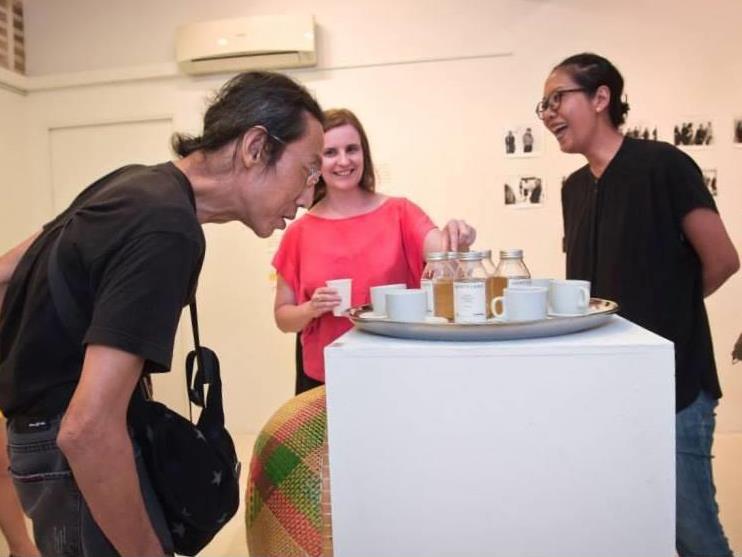Artist Lee Wen (left) looking at Lina Adam’s ‘Tenth course from Culinary History of Singapore Performance Art Re-Presented by Lina Adam’, during the exhibition opening of Notes on Performance; an exhibition curated by 2014 Asialink Arts Resident Kyla McFarlane at Objectifs Gallery, Singapore.
Founded in 1991, Asialink Arts aims to boost Australia-Asia engagement by building Asia-capable arts professionals.
In facilitating Australia’s only dedicated Asia-focused Arts Residency Program Asialink aims to create cross-cultural dialogue, opening the door for arts professionals to work capably in an Asian context. The program supports performing and visual artists, writers and arts managers to take up residencies across a vast geographic and cultural range, from China to Cambodia, India to Indonesia and Thailand to Turkey.
Applications for 2016 Asialink Arts Residencies are now open and will close on 29 September 2015. The residencies offer both individuals and collaborative groups professional development opportunities, aimed at sharing skills, knowledge and networks with local host communities.
Asialink Host Partners range from tertiary art schools to public and private galleries and philanthropic institutions, spanning a variety of art forms, working methodologies and regions. Applicants can also apply for Self-Initiated Residencies by proposing a host or country that is not listed as an Asialink Host Partner.
Reciprocal residencies are also available with hosts in Korea, Taiwan and Japan, enabling two-way knowledge and skills transfer. The program offers direct exchanges between Australian and Asian arts professionals.
Curator and writer Dr Kyla McFarlane knows the value of an Asialink reciprocal residency. She spent three months working on a curatorial project in Singapore at the Art Incubator with founder, director and residency host Charmaine Toh. The project was part of an exchange program with the Victorian College of the Arts in Melbourne.
McFarlane found working in an unfamiliar environment enabled new possibilities in her work as well as important connections.
‘There is a humility that comes with it that has been interesting. Just being somewhere else, it’s a completely different context, and being out of your comfort zone. You realise when you get to a place, it can be confronting, interesting and expanding,’ said McFarlane. ‘It really changed my curatorial focus and my view about the world and how it functions.’
During her residency, McFarlane curated ‘Notes on Performance’, an exploration of the complex nature of documenting performance. The show used a selection of objects, ephemera, documents and relics relating to performance art practice in Singapore.
‘There was a really interesting and quite large community involved in performance practice over in Singapore so there was a lot to engage with in terms of the recent history in Singapore, Singaporean practice and contemporary practice. I brought the Australian works with me as a kind of parallel screening and did a lot of intensive research to get the show up,’ said McFarlane.
This year Asialink is also offering four specific opportunities through its Residency Laboratory, which trials new models of international artistic and cultural exchange.
A month long intensive residency is available for visual artists and arts managers at 3331 Arts Chiyoda in Tokyo, Japan.
The Kerjasama: Reciprocal Residency between Australia and Indonesia enables an Indigenous Australian and an Indonesian artist to undertake a six-week residency in Alice Springs, followed by a six-week residency in Yogyakarta.
For one lucky arts manager there is the year-long Fukutake House Asia Platform which provides a residency at the Setouchi Triennale 2016.
Another program, SymbioticA: The Science of Arts Residencies provides an opportunity for artists interested in the intersections between art and science. It is open to Chinese nationals.
AsialinkArts Residencies raise the profile of Australian arts and introduce contemporary Australian art practice to a broader international audience while affording promising arts professionals a unique immersive experience rooted in the region.
‘What I find interesting about being on residency is you have certain expectations and you get there and what you discover is something much richer but often different to what you first expected,’ said McFarlane, who was surprised by some of the differences with Australian art practice.
‘I hadn’t necessarily thought about it but I got there and the scene is quite different to Melbourne and Australia. I found that interesting, and it was good to be put in this environment with quite a different trajectory and that’s what you want to get out of residencies’.
McFarlane said the skills and knowledge she gained in her 2014 residency are important in her new role as a curator at Queensland Art Gallery of Modern Art (QAGOMA), where she is working within the Australian art collection and currently with the Asia Pacific Triennial(APT) of Contemporary Art.
‘With QAGOMA, the collection and APT, its focus is really engaged strongly in the Asia-Pacific region, so I feel like when I speak to my colleagues who are engaged in Asian art practice that I have far more of an understanding of the region and the different artists that are practicing there and in South-East Asia more broadly,’ she said.
2016 Asialink Arts Residencies
Applications are open and close 5pm AEST, 29 September 2015
Applicants must apply online using SmartyGrants.
For more information visit Asialink.





